Your Market Jeopardy! Winners
Thanks to everyone who participated in our Market Jeopardy! contest. Since no one correctly guessed both of my answers to the question “what caused the large market decline at the end of last year?”, I’ve been forced to grade on a curve. Prizes will be awarded to the two contestants who scored 50%, and to the two with the most entertaining answers. I’ve got hats and tee-shirts to give away; they’re worthless sitting in a closet! Names and comments of the winners revealed at the end of this post. (Three of the four are St. Mary’s H.S. graduates. The nuns must have got something right, other than to tell me in the 6th grade that I was going to hell for using “impure language!”)
First, the incorrect answers
X) The Mueller Investigation – I probably should have phrased this “Russian collusion uncovered in the investigation,” since that is what I really meant. Raymond James Chief Investment Strategist said in December that “this decline is all about Mueller and not about slowing economic metrics . . . .”[1] I respectfully disagreed. I have said from the beginning that there is very little likelihood that there was any collusion between Trump and the Russians re: the election. Trump’s White House is certainly not the good ship Lollypop, but in order for a hull to become encrusted with barnacles, it has to spend more than a few minutes in the water. At the time of the alleged collusion, Trump had simply not been in the political waters long enough for this to happen. Crooked real estate deals? Sex scandals? Sure. Russian collusion? Not likely.
X) Slowing Overseas Economic Growth – I’m not aware of any U.S. recession starting with slower overseas growth. Europe was essentially in a recession in 2012, and industrial production there has slowed markedly in the last year[2], but the U.S. of A. continues to chug along.
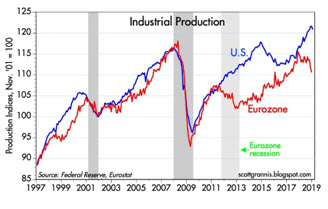
X) Chinese Trade Tiff – It’s a “trade tiff,” not the second coming of Smoot-Hawley.
X) Government Shutdown – This was not the first government shutdown, and as long as Congress abdicates its budgeting responsibilities though omnibus spending bills, it won’t be the last, but the market long ago learned to shrug these hiccups off.
X) Dow Theory Sell Signal – According to classic technical analysis, a “Dow Theory Sell Signal” occurs when a new low in either the Dow Industrial or Dow Transportation Average is confirmed by a new low in the other. This occurred on 12/20/19, after the Fed raised the Fed Funds rate .25% and announced that further gradual increases would be warranted. The DJIA dropped below its 23360 low of 2/9/18, confirming the breakdown in the Transports from earlier in the month. But the Dow Theory Sell Signal didn’t cause the 4th quarter weakness; it was the result of other factors (see “Correct Answers” below.)
X) Housing Market Softness – This is some cause for concern, but as I said in my last post[3], housing stats are notoriously volatile, and it looks like some of the 4th quarter softness is starting to abate, so I don’t think that the housing market was a major contributor to the market’s decline.
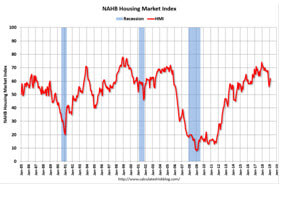
X) Inverted Yield Curve – An inverted yield curve is when short term interest rates rise above long term rates. It is always worrisome, as it indicates a tightening of credit. But the hysterics have gotten ahead of themselves; by most generally accepted definitions of an inverted yield curve, we did not have one in the fourth quarter. Though it is true the yield on the 1-year Treasury Note rose briefly above that of the 5-year Note, the 1-10, 2-10 and 3-30 spreads never went negative in the 4th quarter.
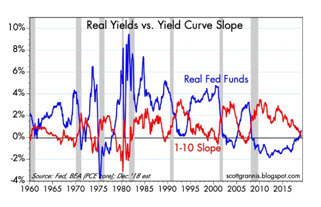
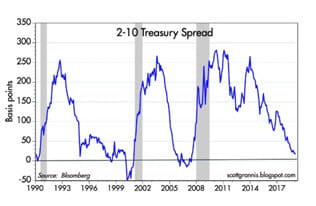
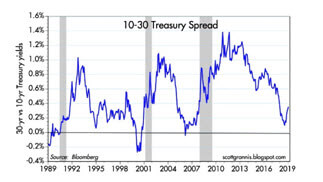
And Now the Correct Answers!
- Hedge Fund Selling – I’ve never been a big believer in “they” explanations for market movements, as in “they’re” manipulating things, the “insiders” are getting out, etc. But in this case, I think there is a high probability that hedge funds had a large influence on the decline. If you are invested in a hedge fund, you can typically only redeem your holdings at the end of the year. Because of poor performance, there were unusually heavy redemption requests for hedge funds in the 4th quarter. Jeff Saut had this to say in December:
Speaking of ‘selling,’ we have written a number of times about the tax loss selling this time of year, mutual fund liquidation, and more importantly the wholesale liquidation going on in the hedge fund complex. To that point, a portfolio manager sent us this yesterday: “At least 144 hedge funds closing and liquidating trillions of dollars. All around the world, with very few buyers in equity markets, probably concentrates this sell off.”[4]
If 144 hedge funds were closing their doors, then hundreds more were forced into significant selling with no regard whatsoever for the prices being received. This was a mini-version of the disastrous “market-to-market accounting” fire sale of 2008, when banks were forced into selling their mortgages, price be damned.
- Federal Reserve Policy – The Federal Reserve has always been the 800-pound gorilla in the room when it comes to the stock market, and 2018 was no exception.
Before the Fed made their rate increase announcement on 12/20, it looked as if the S&P 500 would make a stand around its February low, but the Fed’s words sent the market down another 8%. Here are Scott Grannis’ thoughts from his post “The Fed Screwed Up Badly.”[5]
The interaction of the Fed and the market is a complicated dance, where one leads the other and vice versa. The bond market has been telling the Fed to back off on its plans for higher rates, and I think the Fed has been getting this message . . . .
I would say I made the mistake of believing the Fed knew how to do this dance. Unfortunately, the Fed seems to be dancing with two left feet, and has in the process severely injured the feet of its dancing partner, the market. The Fed did not take the bond market’s advice to back off on its tightening agenda. The Fed ignored the obvious signs of angst that are playing out around the globe, and it ignored the evidence pointing to declining inflation and declining inflation expectations. A pause was called for and warranted; instead the Fed preferred to tighten and to project a further two tightenings next year . . . . And on top of that, Powell said that the unwinding of the Fed’s balance sheet was on “auto-pilot,” as if nothing could go wrong in the interim.
In short, the Fed now has convinced the market that it is more likely than not to over-tighten policy, and that, in turn, raises the spectre of another Fed-induced recession. (Very tight monetary policy is directly responsible for every recession in modern times, as I’ve repeatedly noted in this blog.)
If the Fed does not reverse course or otherwise clarify its intent, soften its stance, or display more concern for the market’s angst, then the chances of a recession will increase significantly. It’s hard to believe that Powell would insist on snatching defeat from the jaws of victory, but that’s the message he has inadvertently sent the market.
There is still plenty of time for Powell to set things straight, because the key financial market and economic fundamentals are still intact. But in the meantime things are likely to get uglier.
The Fed, as it so often is, was way behind the curve. As you can see from this chart[6] of oil prices and inflation expectations, by the time the Fed acted in December, inflation expectations had fallen way below the Fed’s stated inflation target.
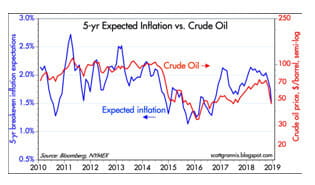
Of course, two weeks later, after Powell met with former Fed chiefs Bernanke and Yellen, the Fed took Scott’s advice and “apologized,” saying there were no more rate increases planned and the Fed would be “listening carefully to the markets.”[7]
And surprise! surprise!, as that noted economic theorist Gomer Pyle would say, the stock market has been rallying ever since.
The Winners
Both Joe and Charlie guessed “federal reserve policy.” Gwenn and Beverly made no attempt to get the answer correct, but will be rewarded for the entertainment value of their efforts!
Gwenn — since most people in government are crazy, my guess is #1 fear that the Easter Bunny will not have enough jelly beans and #2 Climate change
Beverly – Market Jeopardy… so all answers have to do with a market.
- Free range eggs– eggs produced by chickens that run around and are not in cages.
- Grass fed beef – cows who are not given GMO grain
- Organic vegetables – grown without the use of pesticides, synthetic fertilizers, sewage sludge, genetically modified organisms, or ionizing radiation
Hats and tee-shirts on the way!
The information contained in this report does not purport to be a complete description of the securities, markets, or developments referred to in this material. The information has been obtained from sources considered to be reliable, but we do not guarantee that the foregoing material is accurate or complete. Any opinions are those of Don Harrison and Scott Grannis not necessarily those of Raymond James. Expressions of opinion are as of this date and are subject to change without notice. There is no guarantee that these statements, opinions or forecasts provided herein will prove to be correct. Investing involves risk and you may incur a profit or loss regardless of strategy selected. Keep in mind that individuals cannot invest directly in any index, and index performance does not include transaction costs or other fees, which will affect actual investment performance. Individual investor’s results will vary. Past performance does not guarantee future results. Future investment performance cannot be guaranteed, investment yields will fluctuate with market conditions. The S&P 500 is an unmanaged index of 500 widely held stocks that is generally considered representative of the U.S. stock market. Forward looking data is subject to change at any time and there is no assurance that projections will be realized. All investments are subject to risk. The Dow Jones Industrial Average (DJIA), commonly known as “The Dow” is an index representing 30 stock of companies maintained and reviewed by the editors of the Wall Street Journal. Investing in oil involves special risks, including the potential adverse effects of state and federal regulation and may not be suitable for all investors.
[1] Raymond James Investment Strategy, Morning Tack – Most Hated Groups, Jeffrey Saut, 12/18/18. https://myrjnet.rjf.com/ResearchandPlanning/InvestmentStrategy/MarketandEconomicCommentary/MarketStrategybyJeffSaut/Pages/default.aspx
[2] Calafia Beach Pundit, Scott Grannis, U.S. vs. Eurozone Comparisons, 2/15/19 http://scottgrannis.blogspot.com/2019/
[3] Market Jeopardy!, Don Harrison, 3/7/19. http://capitalistinvestment.com/2019/03/market-jeopardy/
[4] Raymond James Investment Strategy, Morning Tack – Fed Day, Jeffrey Saut, 12/19/18. https://myrjnet.rjf.com/ResearchandPlanning/InvestmentStrategy/MarketandEconomicCommentary/MarketStrategybyJeffSaut/Pages/default.aspx
[5] Calafia Beach Pundit, Scott Grannis, The Fed Screwed Up Badly, 12/20/19, http://scottgrannis.blogspot.com/2018/12/the-fed-screwed-up-badly.html
[6] Calafia Beach Pundit, Scott Grannis, The Fed Screwed Up Badly, 12/20/19, http://scottgrannis.blogspot.com/2018/12/the-fed-screwed-up-badly.html
[7] Calafia Beach Pundit, Scott Grannis, The Fed Apologizes and the Outlook Improves, 01/04/19, http://scottgrannis.blogspot.com/2019/01/the-fed-apologizes-and-outlook-improves.html

